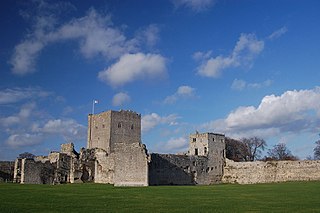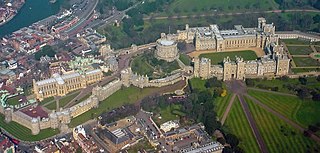Sir Barrington Windsor Cunliffe, known as Barry Cunliffe, is a British archaeologist and academic. He was Professor of European Archaeology at the University of Oxford from 1972 to 2007. Since 2007, he has been an Emeritus Professor.

Portchester Castle is a medieval castle built within a former Roman fort at Portchester to the east of Fareham in the English county of Hampshire. Probably founded in the late 11th century, Portchester was a baronial castle taken under royal control in 1154. The monarchy controlled the castle for several centuries and it was a favoured hunting lodge of King John. It was besieged and captured by the French in 1216 before permanently returning to English control shortly thereafter.

Windsor Castle is a royal residence at Windsor in the English county of Berkshire. It is notable for its long association with the English and later British royal family and for its architecture.

Portus Adurni was a Roman fortress in the Roman province of Britannia situated at the north end of Portsmouth Harbour. Listed in the Notitia Dignitatum, it is generally accepted as having been the structure located at grid reference SU624045 adjoining Portchester in the English county of Hampshire, which was later converted into a medieval castle known as Portchester Castle. It is the best-preserved Roman fort north of the Alps. Around an eighth of the fort has been excavated.

A shell keep is a style of medieval fortification, best described as a stone structure circling the top of a motte.
Roberta Lynn Gilchrist, FSA, FBA is a Canadian-born archaeologist and academic specialising in the medieval period, whose career has been spent in the United Kingdom. She is Professor of Archaeology and Dean of Research at the University of Reading.
John A. A. Goodall, is an English historian, author, and Architectural Editor of Country Life magazine.

Kings Langley Palace was a 13th-century Royal Palace which was located to the west of the Hertfordshire village of Kings Langley in England. During the Middle Ages, the palace served as a residence of the Plantagenet kings of England. It fell into disuse sometime during the 16th century and became a ruin. Today, nothing remains of the building except for some archaeological remains. The site is a scheduled ancient monument.
Warwick James Rodwell is an archaeologist, architectural historian and academic. He is Visiting Professor in the Department of Archaeology, University of Reading, and Consultant Archaeologist to Westminster Abbey, where he is also a member of the College of St Peter in Westminster. He is the author of many books and articles, including the standard textbook on church archaeology. He is a Fellow of the Society of Antiquaries of London, the Society of Antiquaries of Scotland and the Royal Historical Society.
Edward Martyn Jope was an English archaeologist and chemist. He worked temporarily during the Second World War as a biochemist. Following the war, he returned to working in archaeology, first as a medievalist and later as a prehistorian.
The archaeology of Windsor Castle comprises the archaeological investigations at Windsor Castle, Berkshire.
Dr Julian Bennett is a British archeologist.
Helena Francisca Hamerow, FSA is Professor of Early Medieval Archaeology and former Head of the School of Archaeology at Oxford University. She is the author of numerous books and academic articles on archaeology and early medieval history.
Sir Charles Reed Peers was an English architect, archaeologist and preservationist. After a 10-year gap following the death of Lieutenant-General Augustus Pitt Rivers in 1900, Peers became England's second Inspector of Ancient Monuments from 1910 and was then the first Chief Inspector of Ancient Monuments from 1913 to 1933.
Dame Rosemary Jean Cramp, is a British archaeologist and academic specialising in the Anglo-Saxons. She was the first female professor appointed at Durham University and was Professor of Archaeology from 1971 to 1990. She served as President of the Society of Antiquaries of London from 2001 to 2004.
William John Blair, is an English historian, archaeologist, and academic, who specialises in Anglo-Saxon England. He is Professor of Medieval History and Archaeology at the University of Oxford, and a Fellow of The Queen's College, Oxford. He gave the 2013 Ford Lectures at the University of Oxford.
Nancy Margaret Edwards, is a British archaeologist and academic, who specialises in medieval archaeology and ecclesiastical history. Since 2008, she has been professor of Medieval Archaeology at Bangor University.
Laurence Keen, is a British archaeologist, historian, author and art expert. He served as the County Archaeologist for Dorset from 1975 to 1999 and was President of the British Archaeological Association from 1984 to 2004. In 2000 he was awarded the Order of the British Empire for 'services to archaeology'.
Jane Clare Grenville, is a British archaeologist and academic, specialising in the archaeology of medieval buildings. Her early career was in field archaeology, heritage, and building conservation. In 1991, she joined the University of York as a lecturer in archaeology. She served as Pro-Vice-Chancellor for Students from 2007 to 2015 and Deputy Vice-Chancellor from 2012 to 2015: she was acting Vice-Chancellor in 2013.
Georgina Herrmann, is a British retired archaeologist and academic, specialising in Near Eastern archaeology. Having worked as a civil servant, she later studied archaeology and spent the rest of her career as an active field archaeologist and lecturer. She was Reader in the Archaeology of Western Asia at University College London from 1994 to 2002. She was a Member of Council of the British Academy between 2012 and 2015.




